- Регистрация
- 17 Февраль 2018
- Сообщения
- 38 920
- Лучшие ответы
- 0
- Реакции
- 0
- Баллы
- 2 093
Offline
Skip to content

Image: Jon L. Jacobi
 At a glance
At a glance
Expert's Rating
Pros
With light-to-average workloads the CS2342 is an absolutely fantastic performer — the fastest I’ve seen in the 2230 form factor. But for very long writes, it falls well behind the competition.
Price When Reviewed
This value will show the geolocated pricing text for product undefined
Best Pricing Today
Price When Reviewed
1TB: $65 I 2TB: $135
Best Prices Today: PNY CS2342 2230 PCIe 4.0 NVMe SSD
PNY
$96.99

$99.99

$99.99
PNY didn’t fib in its PR — the CS2342 is a mega burner with smaller data sets. In a class of its own. It’s an excellent choice for everyday use or a Steam Deck.
Alas, the relatively sparse allocation of secondary cache means it’s definitely not the drive you want for writing large data sets.
Read on to learn more, then see our roundup of the best SSDs for comparison.
What are the PNY CS2342’s features?
Why PNY chose to name a 2230 (22mm wide, 30mm long) drive the CS2342 when there’s a 2242 form-factor for M.2 SSDs is a puzzler. , there’s a 3 in there rather than a 2, but I did a double-take before I had it out of the box. I’m guessing that more than one buyer will be confused.
, there’s a 3 in there rather than a 2, but I did a double-take before I had it out of the box. I’m guessing that more than one buyer will be confused.
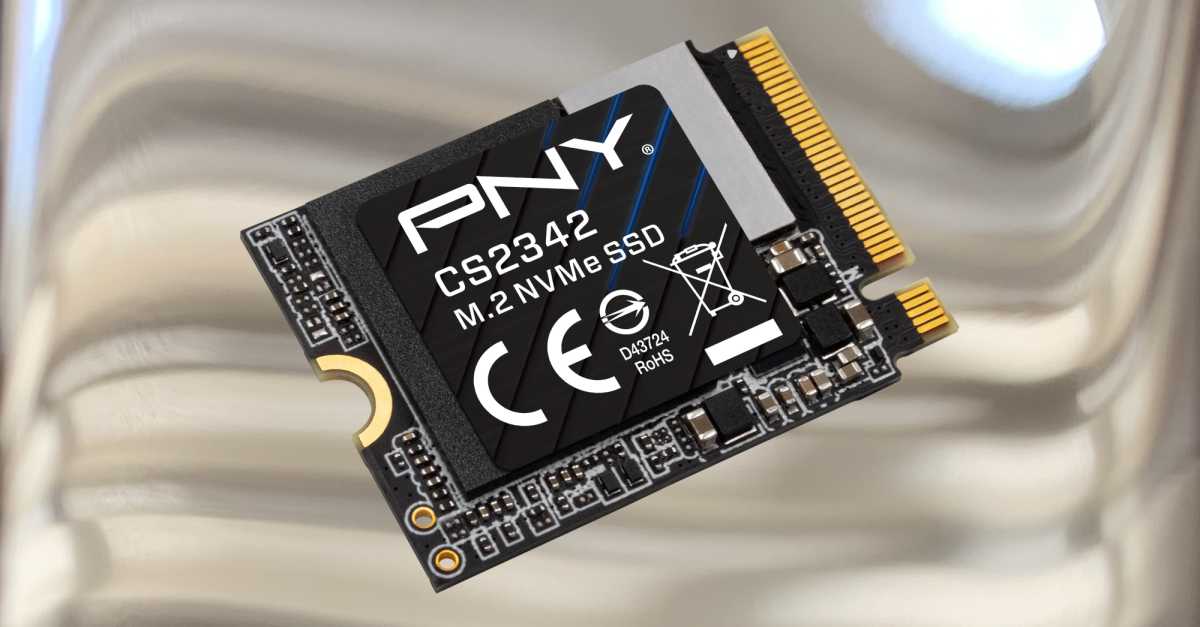
The CS2342 is truly a 2230 form factor, PCIe 4.0 x4, NVMe, M.2 SSD — designed to fit in Steam Decks and other small form-factor devices. The controller is a Phison PS5027-E27-75 host memory buffer (system memory as primary cache) type, and the NAND is fast, layered TLC (see the performance discussion).
PNY warranties the CS2343 for five years, but this is mitigated by a TBW (terabytes that may be written) rating: 600TBW per 1TB of capacity, the norm for TLC, though finding this on the website is impossible.
Most users don’t write nearly as much data as they might suppose, so chalk this up as a largely non-issue. Unless of course you’re a journalist trying to relay facts or a user trying to find them.
How much does the PNY CS2342 cost?
The pricing of the CS2342 is $96.99 for the 1TB version and $161.99 for 2TB, and about $6 less on Amazon, at the time of this writing. That’s a little cheaper than the WD SN770M and Corsair MP600 Core Mini competition (see the performance section) when we checked on Amazon for this review.
The cost of 2230 SSDs is a bit high due to the whole wring-every-last-buck-out-of-gamers thing that Nintendo recently doubled-down on. To that I say, give me MAME.
How fast is the PNY CS2342?
The CS2342’s performance is highly dependent upon the size of the data set you throw at it. As you can see below, it torches the competition in CrystalDiskMark 8 — with a 32GiB test load. That’s a good 2GBps faster than the competition both reading and writing with the lighter load. Certainly nothing to sneeze at.
Alas, I standardized on the 64GiB test load long ago, with which the CS2342 was still impressive while reading, but not nearly so when writing.
For most users, the CS2342’s combination of affordability and lightning-fast sequential transfers with smaller data sets makes it the 2230 SSD to buy.

This is rippingly fast, boys and girls. A good 2GBps faster reading and writing than any other 2230 SSD I’ve tested. It’s too bad I can’t make the write speed official.
The issue is the relatively small amount of secondary cache allotted. Writing anything much beyond 70GB drops speed to the 750MBps native write rate. This affected a number of tests. Note that slowdown shown below only occurred when I didn’t give the drive time to recover after a previous 48GB write.
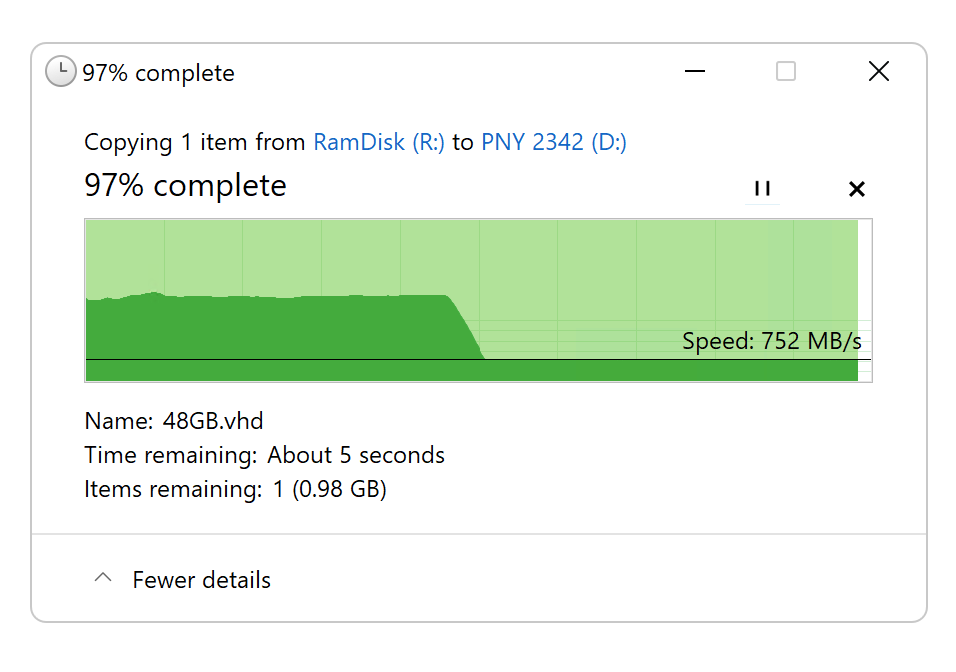
While a 750MBps NAND native write rate is actually spectacular, you buy NVMe for multiple gigabytes per second. That’s what you get, but only with relatively small data sets. As you can see by the point the speed dropped off.
On the sunny side, the 750MBps native write rate is far faster than that of older TLC or current QLC, both of which can drop to hard drive speeds. But it’s not the 3GBps you get with the secondary cache in play. Bummer.
As I just hinted at, while the controller doesn’t allot more secondary cache on the fly, give it a few minutes off and it will replenish the supply
Below are the CS2342’s CrystalDiskMark 8’s 64GiB work load performance numbers. The write is considerably lower than the 6GBps shown in the first graphic, though the 7GBps read speed remains impressive indeed.
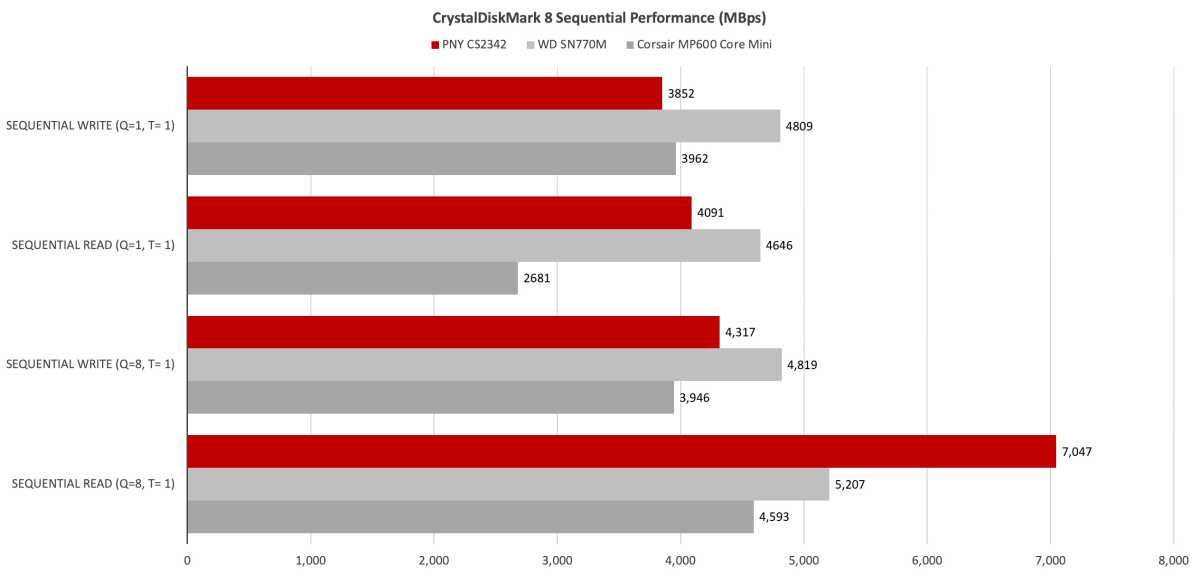
Though the PNY CS2342’s numbers in CrystalDiskMark 8’s sequential throughput tests are good, they’re nowhere near as good as they were with the smaller 32GiB work load.
The PNY CS2342 held its own in CrystalDiskMark 8’s 4K tests, though I was hoping for some more spectacular numbers. Ah, well.
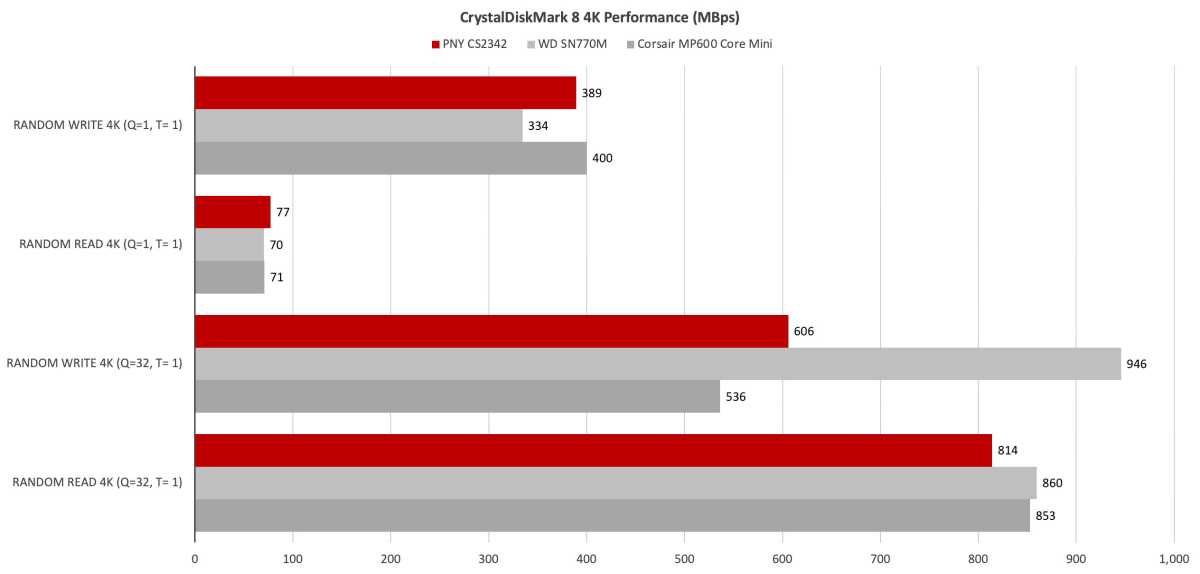
The PNY CS2342 held its own in CrystalDiskMark 8’s 4K tests.
The 48GB file write time in the chart below is with the drive completely empty with plenty of secondary cache available. If you stack the file and folder and single-file writes, you will get lower numbers as shown in the second graphic in this section. As secondary cache tends to be a percentage of available NAND, it’s a good bet that the 1TB drive allots only around 35GB of secondary cache and would turn in a slower time. Still, it’s the fastest of the three drives overall.
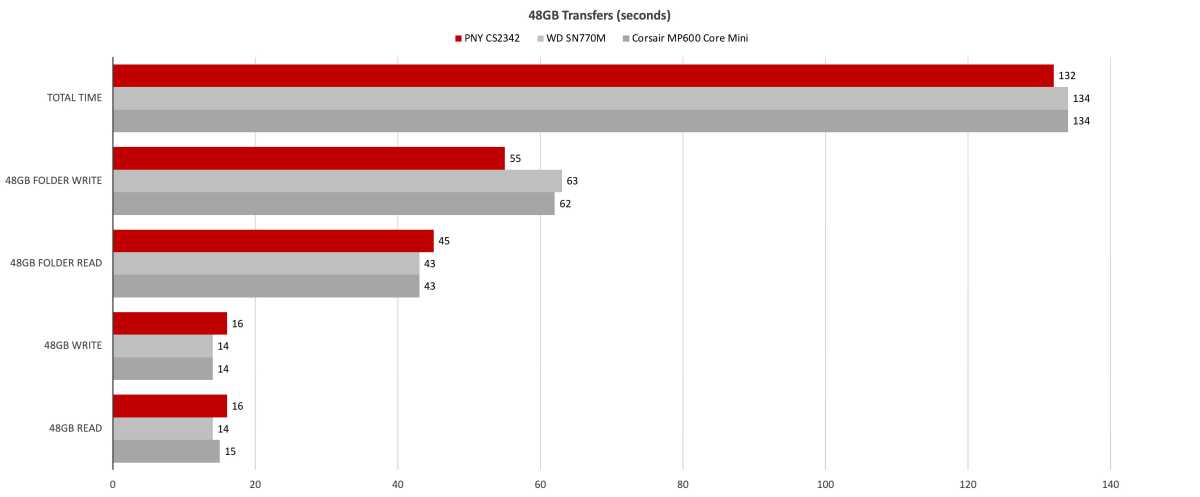
The PNY CS2342 bested its rivals in our 48GB transfer tests. It’s very quick unless you, again, exceed the available secondary cache.
As you can see below, the shortage of secondary cache severely affected the 450GB write time, which slowed at, yes, around the 70GB mark. A 10 minute write time isn’t tragic, but the competition will save you loads of time in this scenario.
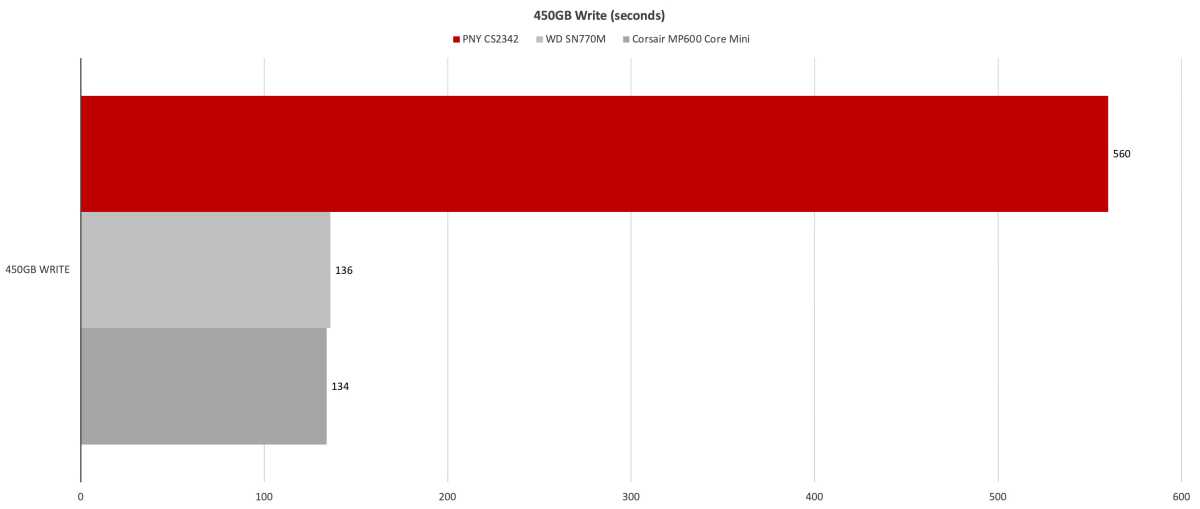
The shortage of secondary cache severely affected the 450GB write time, which slowed at, yes, around the 70GB mark.
With smaller data sets, the CS2342 is capable of far better sequential write performance than the drives it’s compared to. With larger data sets, not so much, though the stellar read rate remains number one.
Stay within the allotted secondary cache and you’re all good. Fall outside of it and you’ll see the slowdowns. This is true with all SSDs, it just happens sooner with the CS2342.
Should you buy the CS2342?
For most users, the CS2342’s combination of affordability and lightning-fast sequential transfers with smaller data sets makes it the 2230 SSD to buy. However, if you regularly write larger amounts of data, look to one of its rivals.
How we test
Our storage tests currently utilize Windows 11 (22H2) 64-bit running on a Z790 (PCIe 5.0) motherboard/i5-12400 CPU combo with two Kingston Fury 32GB DDR5 modules (64GB of memory total). Intel integrated graphics are used. The 48GB transfer tests utilize an ImDisk RAM disk taking up 58GB of the 64GB total memory. The 450GB file is transferred from a Samsung 990 Pro 2TB, which also contains the operating system.
Each test is performed on a newly formatted and TRIM’d drive so the results are optimal. Note that as any drive fills up, performance will decrease due to less NAND for secondary caching, and other factors.
The performance numbers shown apply only to the drive we were shipped as well as the capacity tested. SSD performance can vary by capacity due to more or fewer chips to read/write across and the amount of NAND available for secondary caching (writing TLC/QLC as SLC). Vendors also occasionally swap components. If you ever notice a large discrepancy between the performance you experience and that which we report (systems being roughly equal), by all means — let us know.
Best Prices Today: PNY CS2342 2230 PCIe 4.0 NVMe SSD
PNY
$96.99

$99.99

$99.99
Author: Jon L. Jacobi, Contributor, PCWorld

Jon Jacobi is a musician, former x86/6800 programmer, and long-time computer enthusiast. He writes reviews on TVs, SSDs, dash cams, remote access software, Bluetooth speakers, and sundry other consumer-tech hardware and software.
Recent stories by Jon L. Jacobi:
Adblock test (Why?)

Image: Jon L. Jacobi

Expert's Rating
Pros
- Lightning-fast with light loads
- Very affordable
- 2230 form-factor is suitable for smaller devices such as Steam Decks
- Slows to 750MBps during very long writes
- PNY doesn’t disclose the TBW rating
With light-to-average workloads the CS2342 is an absolutely fantastic performer — the fastest I’ve seen in the 2230 form factor. But for very long writes, it falls well behind the competition.
Price When Reviewed
This value will show the geolocated pricing text for product undefined
Best Pricing Today
Price When Reviewed
1TB: $65 I 2TB: $135
Best Prices Today: PNY CS2342 2230 PCIe 4.0 NVMe SSD
PNY
$96.99

$99.99

$99.99
PNY didn’t fib in its PR — the CS2342 is a mega burner with smaller data sets. In a class of its own. It’s an excellent choice for everyday use or a Steam Deck.
Alas, the relatively sparse allocation of secondary cache means it’s definitely not the drive you want for writing large data sets.
Read on to learn more, then see our roundup of the best SSDs for comparison.
What are the PNY CS2342’s features?
Why PNY chose to name a 2230 (22mm wide, 30mm long) drive the CS2342 when there’s a 2242 form-factor for M.2 SSDs is a puzzler.
 , there’s a 3 in there rather than a 2, but I did a double-take before I had it out of the box. I’m guessing that more than one buyer will be confused.
, there’s a 3 in there rather than a 2, but I did a double-take before I had it out of the box. I’m guessing that more than one buyer will be confused.
The CS2342 is truly a 2230 form factor, PCIe 4.0 x4, NVMe, M.2 SSD — designed to fit in Steam Decks and other small form-factor devices. The controller is a Phison PS5027-E27-75 host memory buffer (system memory as primary cache) type, and the NAND is fast, layered TLC (see the performance discussion).
PNY warranties the CS2343 for five years, but this is mitigated by a TBW (terabytes that may be written) rating: 600TBW per 1TB of capacity, the norm for TLC, though finding this on the website is impossible.
Most users don’t write nearly as much data as they might suppose, so chalk this up as a largely non-issue. Unless of course you’re a journalist trying to relay facts or a user trying to find them.
How much does the PNY CS2342 cost?
The pricing of the CS2342 is $96.99 for the 1TB version and $161.99 for 2TB, and about $6 less on Amazon, at the time of this writing. That’s a little cheaper than the WD SN770M and Corsair MP600 Core Mini competition (see the performance section) when we checked on Amazon for this review.
The cost of 2230 SSDs is a bit high due to the whole wring-every-last-buck-out-of-gamers thing that Nintendo recently doubled-down on. To that I say, give me MAME.
How fast is the PNY CS2342?
The CS2342’s performance is highly dependent upon the size of the data set you throw at it. As you can see below, it torches the competition in CrystalDiskMark 8 — with a 32GiB test load. That’s a good 2GBps faster than the competition both reading and writing with the lighter load. Certainly nothing to sneeze at.
Alas, I standardized on the 64GiB test load long ago, with which the CS2342 was still impressive while reading, but not nearly so when writing.
For most users, the CS2342’s combination of affordability and lightning-fast sequential transfers with smaller data sets makes it the 2230 SSD to buy.

This is rippingly fast, boys and girls. A good 2GBps faster reading and writing than any other 2230 SSD I’ve tested. It’s too bad I can’t make the write speed official.
The issue is the relatively small amount of secondary cache allotted. Writing anything much beyond 70GB drops speed to the 750MBps native write rate. This affected a number of tests. Note that slowdown shown below only occurred when I didn’t give the drive time to recover after a previous 48GB write.

While a 750MBps NAND native write rate is actually spectacular, you buy NVMe for multiple gigabytes per second. That’s what you get, but only with relatively small data sets. As you can see by the point the speed dropped off.
On the sunny side, the 750MBps native write rate is far faster than that of older TLC or current QLC, both of which can drop to hard drive speeds. But it’s not the 3GBps you get with the secondary cache in play. Bummer.
As I just hinted at, while the controller doesn’t allot more secondary cache on the fly, give it a few minutes off and it will replenish the supply
Below are the CS2342’s CrystalDiskMark 8’s 64GiB work load performance numbers. The write is considerably lower than the 6GBps shown in the first graphic, though the 7GBps read speed remains impressive indeed.

Though the PNY CS2342’s numbers in CrystalDiskMark 8’s sequential throughput tests are good, they’re nowhere near as good as they were with the smaller 32GiB work load.
The PNY CS2342 held its own in CrystalDiskMark 8’s 4K tests, though I was hoping for some more spectacular numbers. Ah, well.

The PNY CS2342 held its own in CrystalDiskMark 8’s 4K tests.
The 48GB file write time in the chart below is with the drive completely empty with plenty of secondary cache available. If you stack the file and folder and single-file writes, you will get lower numbers as shown in the second graphic in this section. As secondary cache tends to be a percentage of available NAND, it’s a good bet that the 1TB drive allots only around 35GB of secondary cache and would turn in a slower time. Still, it’s the fastest of the three drives overall.

The PNY CS2342 bested its rivals in our 48GB transfer tests. It’s very quick unless you, again, exceed the available secondary cache.
As you can see below, the shortage of secondary cache severely affected the 450GB write time, which slowed at, yes, around the 70GB mark. A 10 minute write time isn’t tragic, but the competition will save you loads of time in this scenario.

The shortage of secondary cache severely affected the 450GB write time, which slowed at, yes, around the 70GB mark.
With smaller data sets, the CS2342 is capable of far better sequential write performance than the drives it’s compared to. With larger data sets, not so much, though the stellar read rate remains number one.
Stay within the allotted secondary cache and you’re all good. Fall outside of it and you’ll see the slowdowns. This is true with all SSDs, it just happens sooner with the CS2342.
Should you buy the CS2342?
For most users, the CS2342’s combination of affordability and lightning-fast sequential transfers with smaller data sets makes it the 2230 SSD to buy. However, if you regularly write larger amounts of data, look to one of its rivals.
How we test
Our storage tests currently utilize Windows 11 (22H2) 64-bit running on a Z790 (PCIe 5.0) motherboard/i5-12400 CPU combo with two Kingston Fury 32GB DDR5 modules (64GB of memory total). Intel integrated graphics are used. The 48GB transfer tests utilize an ImDisk RAM disk taking up 58GB of the 64GB total memory. The 450GB file is transferred from a Samsung 990 Pro 2TB, which also contains the operating system.
Each test is performed on a newly formatted and TRIM’d drive so the results are optimal. Note that as any drive fills up, performance will decrease due to less NAND for secondary caching, and other factors.
The performance numbers shown apply only to the drive we were shipped as well as the capacity tested. SSD performance can vary by capacity due to more or fewer chips to read/write across and the amount of NAND available for secondary caching (writing TLC/QLC as SLC). Vendors also occasionally swap components. If you ever notice a large discrepancy between the performance you experience and that which we report (systems being roughly equal), by all means — let us know.
PNY
$96.99

$99.99

$99.99
Author: Jon L. Jacobi, Contributor, PCWorld

Jon Jacobi is a musician, former x86/6800 programmer, and long-time computer enthusiast. He writes reviews on TVs, SSDs, dash cams, remote access software, Bluetooth speakers, and sundry other consumer-tech hardware and software.
Recent stories by Jon L. Jacobi:
Adblock test (Why?)
